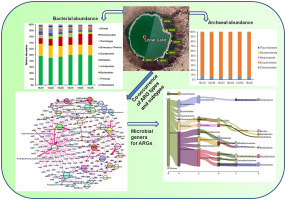Ecotoxicology and Environmental Safety ( IF 6.2 ) Pub Date : 2020-03-07 , DOI: 10.1016/j.ecoenv.2020.110443 Jaya Chakraborty 1 , Vibhavari Sapkale 2 , Vinay Rajput 1 , Manan Shah 1 , Sanjay Kamble 3 , Mahesh Dharne 2

|
Anthropogenic activities mediated antibiotic resistance genes (ARGs) in the pristine aquatic bodies (lakes) is raising concern worldwide. Long read shotgun sequencing was used to assess taxonomic diversity, distribution of ARGs and metal resistance genes (MRGs) and mobile genetic elements (MGEs) in six sites within hypersaline Lonar soda lake (India) prone to various anthropogenic activities. Proteobacteria and Euryarchaeota were dominant phyla under domain Bacteria and Archaea respectively. Higher abundance of Bacteroidetes was pragmatic at sites 18LN5 and 18LN6. Functional analysis indicated 26 broad-spectrum ARGs types, not reported earlier in this ecosystem. Abundant ARG types identified were multidrug efflux, glycopepetide, bacitracin, tetracycline and aminogylcoside resistance. Sites 18LN1 and 18LN5 depicted 167 and 160 different ARGs subtypes respectively and rpoB2, bcrA, tetA(48), mupA, ompR, patA, vanR and multidrug ABC transporter genes were present in all samples. The rpoB2 gene was dominant in 18LN1, whereas bcrA gene in 18LN2-18LN6 sites. Around 24 MRGs types were detected with higher abundance of arsenic in 18LN1 and copper in 18LN2-18LN6, signifying metal contamination linked to MRGs. The bacterial taxa Pseudomonas, Thioalkalivibrio, Burkholderia, Clostridium, Paenibacillus, Bacillus and Streptomyces were significantly associated with ARGs. This study highlights the resistomic hotspots in the lake for deploying policies for conservation efforts.
中文翻译:

gun弹枪的基因组学指导了印度罗纳苏打湖内人为驱动的抵抗性热点的勘探。
人类活动介导的原始水生生物体(湖泊)中的抗生素抗性基因(ARG)引起了全世界的关注。使用长读shot弹枪测序法评估高盐度Lonar苏打湖(印度)中易发生各种人为活动的六个地点的分类学多样性,ARG和金属抗性基因(MRG)以及移动遗传元件(MGE)的分布。变形菌和广古菌门是下分别域细菌和古细菌占主导地位的门类。拟杆菌含量较高在站点18LN5和18LN6上很实用。功能分析表明有26种广谱ARGs类型,在该生态系统中较早时尚未报道。鉴定出的大量ARG类型为多药外排,糖肽,杆菌肽,四环素和氨基糖苷抗性。18LN1和18LN5位点分别描绘了167和160种不同的ARGs亚型,所有样品中均存在rpoB2,bcrA,tetA(48),mupA,ompR,patA,vanR和多药ABC转运蛋白基因。该rpoB2基因是显性的18LN1,而BCRA基因18LN2-18LN6网站。检测到约24种MRGs类型,其中18LN1中的砷含量较高,而18LN2-18LN6中的铜含量较高,这表明与MRGs相关的金属污染。细菌类群假单胞菌,硫碱脂弧菌,伯克霍尔德氏菌,梭状芽孢杆菌,Paenibacillus,芽孢杆菌和链霉菌均与ARGs显着相关。这项研究突出了湖泊中的抵抗性热点,以便为保护工作部署政策。











































 京公网安备 11010802027423号
京公网安备 11010802027423号